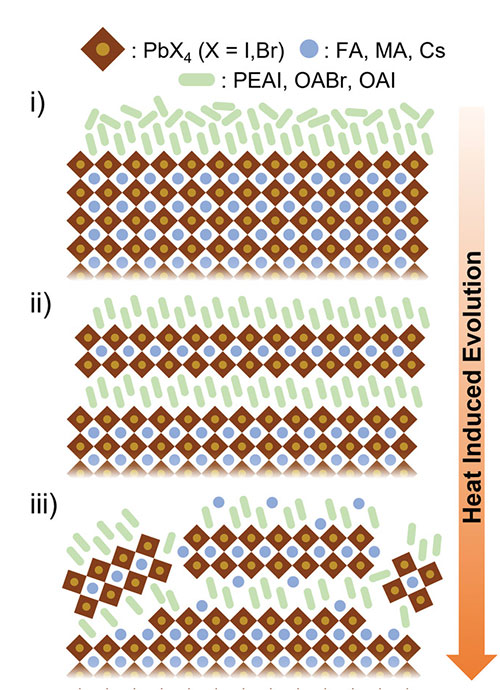Cation Treatment Impacts Stability of Perovskite Solar Cells
Scientists discovered link between manufacturing process and performance
December 14, 2022
 enlarge
enlarge
Schematics of the evolution of the interface treated with bulky cations upon annealing: i) Formation of an organic overlayer; ii) bulky cation diffusion and metal halide Ruddlesden–Popper (RP) phase formation; iii) RP reconstruction. Image credit: Adv. Mats. 2204726 (2022).
The Science
Scientists have discovered that the bulky cation interface of perovskite solar cells affects their stability when the solar cell is heated above 50 C, reducing their performance.
The Impact
Halide perovskites are a promising material for photovoltaics. However, the cation interface used in actual devices is underexplored. This study found that these interfaces can affect the stability of solar cells.
Summary
Halide perovskite solar cells offer a cost-effective way to produce green energy. However, their surfaces are treated with organic salts—more specifically, with the bulky cations in the salts. While this is a common practice, the actual effects at a microscopic level have been unexplored.
In this study, a team of researchers discovered that this common treatment changes the structure and the optoelectronic performance of halide perovskite solar cells when exposed to heat. The team used a combination of research techniques, including the Complex Materials Scattering (CMS) beamline at the National Synchrotron Light Source II (NSLS-II), a U.S. Department of Energy (DOE) Office of Science user facility located at DOE’s Brookhaven National Laboratory, to gather information about the structural changes in the material.
The team discovered the formation of an organic layer on top of the perovskite, but when the material is heated another phase emerges as cations move into the material. This then leads to the reconstruction of the layers. This reconstructed layer is less effective against air and moisture. Once the layer is formed, the performance of the device drops suddenly within the first 200 hours of operation and then stabilizes.
Overall, the authors conclude that a thermal stress test should be considered for these devices to ensure the long-term stability of the solar cells. In addition, they suggest looking for other treatment options to prevent performance degradation.
Download the research summary slide (PDF)
Contact
Juan-Pablo Correa-Baena
jpcorrea@gatech.edu
Georgia Institute of Technology
Publication
Carlo Andrea Riccardo Perini, Esteban Rojas-Gatjens, Magdalena Ravello, Juanita Hidalgo, Yu An, Sanggyun Kim, Barry Lai, Ruipeng Li, Juan-Pablo Correa-Baena, Andrés-Felipe Castro-Mendez, Carlos Silva-Acuña Interface Reconstruction from Ruddlesden–Popper Structures Impacts Stability in Lead Halide Perovskite Solar Cells. Advanced Materials., 2204726 (2022). DOI: 10.1002/adma.202204726
Funding
C.A.R.P. thanks Monikandan Rebhadevi for the useful discussion and study material provided for the analysis of the XPS data collected in this work. E.R.G. thanks David A. Valverde-Chavez and Jacob Williamson for their participation in the construction of the ECPL experiment, and Ajay Ram Srimath Kandada for a fruitful discussion regarding the ECPL interpretation. C.S.A. and E.R.G. received funding from the U.S. Department of Energy's Office of Energy Efficiency and Renewable Energy (EERE) under the Solar Energy Technologies Office Award Number DE-EE0008747. C.S.A. acknowledges support from the National Science Foundation (Grant DMR-1904293) and from the School of Chemistry and Biochemistry and the College of Science of Georgia Institute of Technology. C.A.R.P. and J.P.C.B. received financial support from the U.S. Department of Energy's Office of Energy Efficiency and Renewable Energy (EERE) under the Solar Energy Technologies Office Award Number DE40 EE0009369. This research used the CMS beamline of National Synchrotron Light Source II, a U.S. Department of Energy (DOE) Office of Science User Facility operated for the DOE Office of Science by Brookhaven National Laboratory under contract DE-SC0012704.
2022-21020 | INT/EXT | Newsroom









